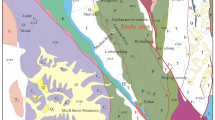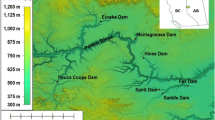Abstract
The Wenchuan earthquake triggered many landslides and numerous avalanches and created 100 odd quake lakes. The quake lakes may be removed or preserved. The removal strategy was applied to several large landslide dams, which were dangerous because massive amounts of water pooled up in the quake lakes. The dams could eventually fail under the action of dam outburst flooding, potentially endangering the lives of people in the downstream reaches. This paper studied the stability of landslide dams and the development of knickpoints by field investigations and experiments, and analyzing satellite images. The study concluded that if landslide dams were preserved, they would develop into knickpoints and act as a primary control of riverbed incision and, thus, reduce the potential of new landslide. The stability of landslide dams depends mainly on the development of the step-pool system and stream power of the flood flow. If a landslide dam consists of many boulders, a step-pool system may develop on the spillway channel of the dam, which would maximize the resistance, consume most of the flow energy and consequently protect the dam from incision. The development degree of the step-pool system is represented by a parameter S p, which was measured with a specially designed instrument. A preservation ratio of landslide dams is defined as the ratio of preserved height after flood scouring to the original height of the dam. For streams with peak flood discharge lower than 30 m3/s, the preservation ratio is linearly proportional to S p. For rivers with a peak flood discharge higher than 30 m3/s (30–30,000 m3/s), the minimum S p value for stable channel increases with log p, in which p is the unit stream power. For a landslide dam with a poorly developed step-pool system, S p is smaller than the minimum value and the outburst flood incises the spillway channel and causes failure of the dam. For preserved landslide dams, sediment deposits in the quake lakes. A landslide dam may develop into a knickpoint if it is stabilized by long-term action of the flow. Large knickpoints can totally change the fluvial processes and river morphology. Uplift of the Qinghai–Tibetan Plateau has caused extensive channel bed incision along almost all rivers. For many rivers, the incision has been partly controlled by knickpoints. Upstream reaches of a knickpoint have a new and unchanging base level. This brings about a transition from degradation to aggradation and from vertical bed evolution to horizontal fluvial process. Multiple and unstable channels are prominent in the reaches, upstream of the knickpoints. If hundreds of landslide dams occurred simultaneously on a reach of a mountain river, the potential energy of bank failure and the slope erosion would be greatly reduced and sediment yield from the watershed may be reduced to nearly zero. The quake lakes may be preserved long term and become beautiful landscapes. Streams with long-term unfilled quake lakes have good aquatic ecology.















Similar content being viewed by others
References
Becker JS, Johnston DM, Paton D, Hancox GT, Davies TR, McSaveney MJ, Manville VR (2007) Response to landslide dam failure emergencies: issues resulting from the October 1999 mount adams landslide and dam-break flood in the Poerua River, Westland, New Zealand. Nat Hazards Rev 8(2):35–42. doi:10.1061/(ASCE)1527-6988(2007)8:2(35)
Costa JE, Schuster RL (1988) The formation and failure of natural dams. Geol Soc Amer Bull 100:1054–1068. doi:10.1130/0016-7606(1988)100<1054:TFAFON>2.3.CO;2
Crozier MJ, Pillans BJ (1991) Geomorphic events and landform response in south-eastern Taranaki, New Zealand. Catena 18:471–487. doi:10.1016/0341-8162(91)90050-8
Dong JJ, Tung YH, Chen CC et al (2009) Discriminant analysis of the geomorphic characteristics and stability of landslide dams. Geomorphology 110:162–171. doi:10.1016/j.geomorph.2009.04.004
Gaziev E (1984) Study of the Usoi landslide in Pamir. In: Proceedings of the 4th International Symposium on Landslides, Toronto, 1:511–514
Geertsema M, Pojar JJ (2007) Influence of landslides on biophysical diversity–a perspective from British Columbia. Geomorphology 89:55–69. doi:10.1016/j.geomorph.2006.07.019
Hancox GT, Perrin ND, Dellow GD (1997) Earthquakeinduced landsliding in New Zealand and implications for MM intensity and seismic hazard assessment. Client Rep. No. 43601B, Institute of Geological and Nuclear Sciences, Wellington, New Zealand
Harkins N, Kirby E, Heimsath A et al (2007) Transient fluvial incision in the headwaters of the Yellow River, northeastern Tibet, China. J Geophys Res 112:F03S04. doi:10.1029/2006JF000570
Hegan BD, Johnson JD, Stevens C (2001) Landslide risk from the Hipaua Geothermal Area near Waihi Village at the southern end of Lake Taupo. Engineering in Hazardous Terrain, In: Proceedings of New Zealand Geotechnical Society Symposium, Christchurch, pp 439–448
Hovius N, Stark CP (2006) Landslides from Massive Rock Slope Failure. Springer, The Netherlands
IGNS (Institute for Geological and Nuclear Sciences) (2003) GeoNet News, Lower Hutt, 2:8
Korup O (2002) Recent research on landslide dams–a literature review with special attention to New Zealand. Prog Phys Geogr 26(2):206–235. doi:10.1191/0309133302pp333ra
Korup O (2004a) Landslide-induced river channel avulsions in mountain catchments of southwest New Zealand. Geomorphology 63:57–80. doi:10.1016/j.geomorph.2004.03.005
Korup O (2004b) Geomorphometric characteristics of New Zealand landslide dams. Eng Geol 73:13–35. doi:10.1016/j.enggeo.2003.11.003
Korup O (2005a) Geomorphic hazard assessment of landslide dams in South Westland, New Zealand: Fundamental problems and approaches. Geomorphology 66:167–188. doi:10.1016/j.geomorph.2004.09.013
Korup O (2005b) Geomorphic imprint of landslides on alpine river systems, southwest New Zealand. Earth Surf Proc Land 30(7):783–800. doi:10.1002/esp.1171
Korup O, Strom A, Weidinger J (2006) Fluvial response to large rock-slope failures: Examples from the Himalayas, the Tien shan, and the southern Alps in New Zealand. Geomorphology 78(1–2):3–21. doi:10.1016/j.geomorph.2006.01.020
Liu HX (2009) Research on the distribution of streambed structures and their influence on fluvial morphology. Tsinghua University, PhD dissertation, p 136 (in Chinese)
Maxwell AR, Papanicolau AN (2001) Step-pool morphology in high-gradient streams. Int J Sediment Res 16:380–390
National Panel of Wenchuan Earthquake (2008) Atlas of geological and earthquake disasters of the Wenchuan Earthquake, Sinomaps Press, Beijing (in Chinese)
Nicoletti PG, Parise M (2002) Seven landslide dams of old seismic origin in southeastern Sicily (Italy). Geomorphology 46:203–222. doi:10.1016/S0169-555X(02)00074-0
Ouimet WB, Whipple KX, Royden LH, Sun ZM, Chen ZL (2007) The influence of large landslides on river incision in a transient landscape: Eastern margin of the Tibetan Plateau (Sichuan, China). GSA Bull 119(11–12):1462–1476. doi:10.1130/B26136.1
Rosport M (1997) Hydraulics of steep mountain streams. Int J Sediment Res 12(3):99–108
Safran EB, Peden D, Harrity K et al. (2008) Impact of landslide dams on river profile evolution. American Geophysical Union, Fall Meeting, abstract #H54D-03
Schuster RL, Alford D (2004) Usoi landslide dam and Lake Sarez, Pamir Mountains, Tajikistan. Environ Eng Geosci 10(2):151–168. doi:10.2113/10.2.151
Shang YJ, Yang ZF, Li LH et al (2003) A super-large landslide in Tibet in 2000: background, occurrence, disaster, and origin. Geomorphology 54(3–4):225–243. doi:10.1016/S0169-555X(02)00358-6
Sichuan Seismological Bureau (1983). The Diexi Earthquake in 1933. Sichuan Science and Technology Press, Chengdu (in Chinese)
SSB-FU (State Seismological Bureau and Fudan University) (1983). Atlas of the historical earthquakes in China—the Qing Dynasty Period, Sinomaps Press, Beijing (in Chinese)
Strom KB, Papanicolaou AN (2007) ADV measurements around a cluster microform in a shallow mountain stream. J Hydraul Eng 133(12):1379–1389. doi:10.1061/(ASCE)0733-9429(2007)133:12(1379)
Takahisa Mizuyama, Yoshifumi Satohuka, Kiichiro Ogawa et al (2006) Estimating the outflow discharge rate from landslide dam outbursts. Disaster Mitigation of debris flows, slope failures and landslides. Universal Academy Press, Tokyo, pp 365–377
Wang ZY, Xu J, Li CZ (2004) Development of step-pool sequence and its effects in resistance and stream bed stability. Int J Sediment Res 19(3):161–171
Wang GQ, Liu F, Fu XD, Li TJ (2008) Simulation of dam breach development for emergency treatment of the Tangjiashan Quake Lake in China. Science in China Series E: Technol Sci, 51(SII):82–94. doi:10.1007/s11431-008-6019-9
Wang ZY, Cui P, Wang RY (2009a) Mass movements triggered by the Wenchuan Earthquake and management strategies of quake lakes. Int J River Basin Manag 7(1):1–12
Wang ZY, Melching CS, Duan XH, Yu GA (2009b) Ecological and hydraulic studies of Step-pool systems. J Hydraul Eng 135(9):705–717. doi:10.1061/(ASCE)0733-9429(2009)135:9(705)
Wilcox A, Nelson JM, Wohl EE (2006) Flow resistance dynamics in step-pool channels 2: partitioning between grain, spill, and woody debris resistance. Water Resour Res 42:W05419. doi:10.1029/2005WR004278
Wohl EE, Thompson DM (2000) Velocity fluctuations along a small step-pool channel. Earth Surf Process Landf 25(4):353–367
Acknowledgments
The study is supported by the Ministry of Science and Technology of China (2008CB425803) and Tsinghua University (2009THZ02234, 2009-ZY-2).
Author information
Authors and Affiliations
Corresponding author
Rights and permissions
About this article
Cite this article
Wang, Z., Cui, P., Yu, Ga. et al. Stability of landslide dams and development of knickpoints. Environ Earth Sci 65, 1067–1080 (2012). https://doi.org/10.1007/s12665-010-0863-1
Received:
Accepted:
Published:
Issue Date:
DOI: https://doi.org/10.1007/s12665-010-0863-1




